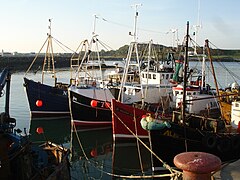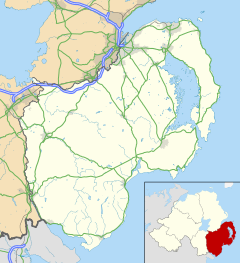Ardglass
Ardglass
| |
|---|---|
 Ardglass Harbour, May 2009 | |
Location within County Down | |
| Population | 1,668 [1] |
| • Belfast | 34.1 mi |
| District | |
| County | |
| Country | Northern Ireland |
| Sovereign state | United Kingdom |
| Post town | ARDGLASS |
| Postcode district | BT30 |
| Dialling code | 028 |
| UK Parliament | |
| NI Assembly | |

Ardglass (from Irish Ard Ghlais 'green height')[2] is a coastal fishing village, townland (of 321 acres) and civil parish in County Down, Northern Ireland, in the historic barony of Lecale Lower.[3] It is still a relatively important fishing harbour. It is situated on the B1 Ardglass to Downpatrick road, about 6 miles (11 kilometres) to the south east of Downpatrick, in the Lecale peninsula on the Irish Sea. It had a population of 1,668 people in the 2001 Census, and is located within the Down District Council area.
The village is a commuter centre for workers in Downpatrick and Belfast, a seaside resort and a local service centre providing housing and a variety of shops and services largely concentrated in Castle Place, Quay Street, Kildare Street and Bath Street. A Conservation area was designated in Ardglass in 1996, focused on its early 19th century street pattern. The village has eight archaeological sites within the area and another two nearby. There are a number of listed properties located on Castle Place, Kildare Street and The Crescent. St Nicholas's Church, King's Castle, Ardglass Castle, Isabella Tower, the disused railway station, the North Pier and the inner Dock are also listed.
History
Ardglass grew from a place of little note in the 13th century to a modestly prosperous port in the 15th century.[4] It was an important town and port in the Middle Ages, but no harbour works seem to have been constructed until after 1812. Then William Ogilvie, who had acquired the Ardglass estate, had a harbour built. Further extensions to the pier and a lighthouse were made, but in 1838 a great storm undermined the lighthouse which fell into the sea along with the end of the pier.[citation needed] Work on the piers was completed by 1885 and they remain in use to this day.
Ardglass contains more medieval tower-houses than any other town in Ireland, a total of four, reflecting its importance as Ulster's busiest port in the 15th century. It also has probably the most extensive network of warehouses from the period surviving in Ireland. These were important in the substantial grain export trade of the fourteenth and fifteenth centuries. Fortifications survive in the town from the fifteenth century, including Jordan's Castle, the most imposing of a ring of towers built around the harbour to secure the then important Anglo-Norman trading port, King's Castle and Cowd Castle. Nearby are the ruins of 15th century Ardtole Church.
Account of Ardglass in 1833
The Dublin Penny Journal of 30 March 1833[5] describes Ardglass as follows:
Ardglass is picturesquely situated on the shore of a little harbour of the same name, in the Barony of Lecale, seven miles S.E. of Downpatrick; and though now a mean village, with very few inhabitants, ranked, anciently, as the principal town of trade, next to Carrickfergus, in the province of Ulster. Its harbour, however, which is iron-bound and full of rocks, is only fit for fishing vessels to enter; for which reason the out-trade was, for the most part, carried on in Killough harbour, from thence called by Speed, the haven of Ardglass. Its antiquity is very great, as a church was founded here by St. Patrick. It is said to have been a borough, though on its ruin the privilege of returning members to parliament went into disuse; in the reign of Henry the VI. it was a corporation, governed by a Portrieve.
Economy
Ardglass has been a fishing port for more than two thousand years and developed as such due to its location on the east coast of Lecale and its sitting by a natural inlet. It has one of the few harbours which is accessible at all states of the tide and today has two fishing piers, the North Pier and South Pier, a number of fish processing factories and a marina. While the port is not as busy now as in its heyday, 150 years ago, up to £5 million passes through the fish trade here every year. The port specialises in herrings, prawns, and whitefish.
Places of interest
- Ardglass Marina, sometimes also known as Phennick Cove, has a capacity for about 80 craft and a deep water basin open 24 hours daily all year. Strangford Lough lies six miles to the north.
- Ardglass Golf Club is the local course. The Clubhouse was formerly known as Ardglass Castle and the building dates from the 15th century. The course won an award in 2011 as the best links course in Ireland. The course record at Ardglass Golf Club is 63.
- Jordan's Castle is a ruined 15th-century tower house and one of several in Ardglass, underlining the town's historic importance to the life of the district. It can be found between Kildare and Quay Streets.
- Isabella's Tower, a folly built on top of a hill by Aubrey de Vere Beauclerc in the 19th century as a gazebo for his invalid daughter.
- Ardtole Church is a 15th-century ruined church standing on a hilltop overlooking the Irish Sea and the Isle of Man, 0.75 miles (1.2 km) north-east of Ardglass, at grid ref: J564382.[6]
Transport
Ardglass railway station on the Belfast and County Down Railway, opened on 8 July 1892, but finally closed on 16 January 1950.[7]
Sport
Ardglass F.C. play association football in the Northern Amateur Football League.
People
- Thomas Hunter, founder and president of Hunter College in New York City was born in Ardglass.
- Gerry Kelly lives in Ardglass.
Demography
Ardglass is classified as a village.[8] On Census day (29 April 2001) there were 1,668 people living in Ardglass. Of these:
- 27.3% were aged under 16 and 18.8% were aged 60 and over
- 48.1% of the population were male and 51.9% were female
- 87.9% were from a Catholic background and 10.2% were from a Protestant background
- 5.3% of people aged 16–74 were unemployed.
Civil parish of Ardglass
The civil parish includes the village of Ardglass.[3]
Townlands
The civil parish contains the following townlands:[3] Ardglass, Ardtole, Coney Island, Ringfad and Tullycarnan
See also
References
- ^ 2001 Census
- ^ Placenames NI Archived 31 March 2012 at the Wayback Machine
- ^ a b c "Ardglass". IreAtlas Townlands Database. Retrieved 17 April 2015.
- ^ Mallory, J. P.; McNeill, T. E. (1991). The Archaeology of Ulster from Colonization to Plantation. Belfast: Institute of Irish Studies, QUB. p. 286.
- ^ "Ardglass, County of Down". Library Ireland – from the Dublin Penny Journal, Volume 1, Number 40, March 30, 1833. Retrieved 17 June 2008.
{{cite web}}: Italic or bold markup not allowed in:|work=(help) - ^ Department of the Environment for Northern Ireland (1983). Historic Monuments of Northern Ireland. Belfast: HMSO. pp. 96–97.
- ^ "Ardglass station" (PDF). Railscot – Irish Railways. Archived from the original (PDF) on 26 September 2007. Retrieved 8 September 2007.
{{cite web}}: Unknown parameter|deadurl=ignored (|url-status=suggested) (help) - ^ NI Statistics and Research Agency (NISRA)
- Draft Ards and Down Area Plan 2015
- Ardglass Golf Club
- Discover Northern Ireland
- Down District Council
- Culture Northern Ireland
External links
- From Ireland – Ardglass, description from Lewis's Topographical Dictionary of Ireland, 1837
- Photograph of Ardglass Railway Station
- Have a Look at Ardglass
- Royal Irish Academy – Three Medieval Buildings in the Port of Ardglass, Co. Down by T.E. McNeill, published 15 April 2005
- A short history of Dunsford and Ardglass




